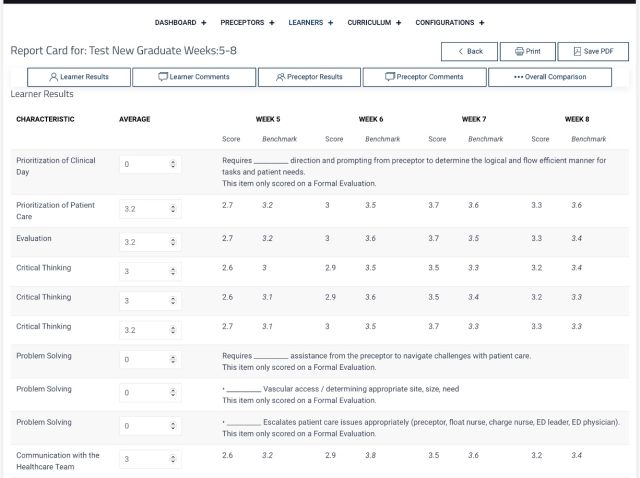Benchmark Performance
Individualize each Learner's experience and understand how changes and external influences impact Learner performance.
Project: Benchmark Learner Performance
Innovation
Compare previous cohorts to current Learner progress, identify priority areas
Topic
Learner Evaluation
First, one must recognize that no nurse started as the nurse they are today. The individual nurse develops their practice over time. A typical orientation process is to evaluate a Learner's performance at a few intervals, identify deficits, and establish a plan. The orientation conversation may be focused on failures rather than progress. Converting the orientation evaluations from infrequently completed to daily assessments creates sufficient data to show progress over time. These progress points can be compared to similar learners at the same point in their orientation. An educator can then consider the following:
"Why is this learner ahead or behind?"
"What element in their practice has improved the most?"
"Can we build on their progress?"
A traditional Orientation Process is often prescribed for several weeks, specific required experiences and classes, and regulatory documentation. A more effective method is developing a Learner's Clinical judgment skills. The Learner, in various situations, must be able to independently practice in a way that meets the patient's clinical needs, collaborates with providers, patients, and families, utilizes resources to problem solve, and balances the needs of all the patients on their team.
Planning a New Approach
Comparing a learner's performance to a benchmark is helpful because it provides a precise measurement standard. It allows educators and orientation conversations between the learner and the orientation team to assess progress, identify strengths and weaknesses, set achievable goals, and tailor instruction accordingly. Benchmarks provide context, helping learners understand their standing within a larger framework and motivating them to strive for improvement.
Challenge
Measure Clinical Judgement
Before the existence of the NTS Learning Center orientation tracking system, the orientation team had attempted infrequent written evaluations that aimed for a learner to reflect with their preceptor on how much assistance they needed in the following domains: Prioritization, Critical Thinking, Problem-Solving, Documentation, Delegation, and more.
Solution
Web-Based Evaluations
Later, the orientation team piloted the use of electronic Google Docs forms that Learners and Preceptors were encouraged to complete each shift. Since then, the NTS Learning Center has evolved to evaluate the learning achieved in Simulation Labs, Skill Sessions, and Classes. Having all the data in one place allows the team to identify how different actions lead to different results. A learner is considered for independent practice when they can exercise Clinical judgment in various situations without their preceptor at least 75% of the time. Ideally, closer to >90% of the time.
Planning
Build a Comparison Group
A benchmark is a standard or reference point used for comparison and measurement. It serves as a point of reference against which the performance, quality, or characteristics of something can be evaluated. Before a benchmark can exist, there must be an initial cohort of Learners to start data collection. Once an initial group's data collection is completed, future groups can compare individual scores to data averaged across several factors to identify it as a like-kind comparison. The data elements are then used to create a comparison:
-
Learner Type (New Graduates, Experienced RN hires, ED Experienced RNs)
-
Location / Department
-
Role
-
Orientation Week
Evaluate
Factors That Can Influence a Learner's Progress
The photo below compares a cohort of like-kind Learners; it is looking to identify the week when the Learner could practice independently within the domain at least 75% of the time.
The highlighted Learner was a delayed start from the previous cohort and was the only New Graduate on Orientation for the first eight weeks of their Orientation. This Learner experienced overcrowding in their first several weeks of Orientation, limiting their preceptor's availability to explain things while on shift. They were delayed starting the orientation simulation curriculum which the study site presents in the Simulation Lab. Finally, without other Learners on Orientation, the highlighted Learner had fewer people to turn to for support when they were experiencing challenges.
The result is clear: the highlighted Learner was slow to progress, resulting in a longer, more expensive orientation.

-
Overcrowding, the study site uses NEDOCS (National Emergency Department Overcrowding Score) Scores >140 (Severly Overcrowded) can be correlated with delays in making progress.
-
Receiving the Orientation Curriculum out of order or delayed.
-
Starting outside of a cohort
Would you like a demonstration?
saving...


